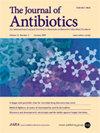Uncovering the potentiality of quinazoline derivatives against Pseudomonas aeruginosa with antimicrobial synergy and SAR analysis
IF 2.1
4区 医学
Q3 BIOTECHNOLOGY & APPLIED MICROBIOLOGY
引用次数: 0
Abstract
Antimicrobial resistance has emerged as a covert global health crisis, posing a significant threat to humanity. If left unaddressed, it is poised to become the foremost cause of mortality worldwide. Among the multitude of resistant bacterial pathogens, Pseudomonas aeruginosa, a Gram-negative, facultative bacterium, has been responsible for mild to deadly infections. It is now enlisted as a global critical priority pathogen by WHO. Urgent measures are required to combat this formidable pathogen, necessitating the development of novel anti-pseudomonal drugs. To confront this pressing issue, we conducted an extensive screening of 3561 compounds from the ChemDiv library, resulting in the discovery of potent anti-pseudomonal quinazoline derivatives. Among the identified compounds, IDD-8E has emerged as a lead molecule, exhibiting exceptional efficacy against P. aeruginosa while displaying no cytotoxicity. Moreover, IDD-8E demonstrated significant pseudomonal killing, disruption of pseudomonal biofilm and other anti-bacterial properties comparable to a well-known antibiotic rifampicin. Additionally, IDD-8E’s synergy with different antibiotics further strengthens its potential as a powerful anti-pseudomonal agent. IDD-8E also exhibited significant antimicrobial efficacy against other ESKAPE pathogens. Moreover, we elucidated the Structure-Activity-Relationship (SAR) of IDD-8E targeting the essential WaaP protein in P. aeruginosa. Altogether, our findings emphasize the promise of IDD-8E as a clinical candidate for novel anti-pseudomonal drugs, offering hope in the battle against antibiotic resistance and its devastating impact on global health.


通过抗菌协同作用和 SAR 分析揭示喹唑啉衍生物抗铜绿假单胞菌的潜力。
抗菌药耐药性已成为一个隐蔽的全球健康危机,对人类构成重大威胁。如果不加以解决,它将成为全球死亡的首要原因。在众多具有抗药性的细菌病原体中,铜绿假单胞菌是一种革兰氏阴性、兼性细菌,一直是造成轻微至致命感染的罪魁祸首。世卫组织现已将其列为全球重大优先病原体。要对付这种可怕的病原体,必须采取紧急措施,开发新型抗假单胞菌药物。面对这一紧迫问题,我们对 ChemDiv 库中的 3561 个化合物进行了广泛筛选,最终发现了强效抗假性喹唑啉衍生物。在已发现的化合物中,IDD-8E 是一个先导分子,它对铜绿假单胞菌具有卓越的疗效,同时没有细胞毒性。此外,IDD-8E 还表现出显著的假菌丝杀伤力、破坏假菌丝生物膜以及其他抗菌特性,可与著名抗生素利福平相媲美。此外,IDD-8E 与不同抗生素的协同作用进一步增强了其作为强效抗假菌体药物的潜力。IDD-8E 对其他 ESKAPE 病原体也有显著的抗菌效果。此外,我们还阐明了 IDD-8E 针对铜绿假单胞菌必需的 WaaP 蛋白的结构-活性关系 (SAR)。总之,我们的研究结果强调了 IDD-8E 作为新型抗假丝酵母药物临床候选药物的前景,为抗击抗生素耐药性及其对全球健康的破坏性影响带来了希望。
本文章由计算机程序翻译,如有差异,请以英文原文为准。
求助全文
约1分钟内获得全文
求助全文
来源期刊

Journal of Antibiotics
医学-免疫学
CiteScore
6.60
自引率
3.00%
发文量
87
审稿时长
1 months
期刊介绍:
The Journal of Antibiotics seeks to promote research on antibiotics and related types of biologically active substances and publishes Articles, Review Articles, Brief Communication, Correspondence and other specially commissioned reports. The Journal of Antibiotics accepts papers on biochemical, chemical, microbiological and pharmacological studies. However, studies regarding human therapy do not fall under the journal’s scope. Contributions regarding recently discovered antibiotics and biologically active microbial products are particularly encouraged. Topics of particular interest within the journal''s scope include, but are not limited to, those listed below:
Discovery of new antibiotics and related types of biologically active substances
Production, isolation, characterization, structural elucidation, chemical synthesis and derivatization, biological activities, mechanisms of action, and structure-activity relationships of antibiotics and related types of biologically active substances
Biosynthesis, bioconversion, taxonomy and genetic studies on producing microorganisms, as well as improvement of production of antibiotics and related types of biologically active substances
Novel physical, chemical, biochemical, microbiological or pharmacological methods for detection, assay, determination, structural elucidation and evaluation of antibiotics and related types of biologically active substances
Newly found properties, mechanisms of action and resistance-development of antibiotics and related types of biologically active substances.
 求助内容:
求助内容: 应助结果提醒方式:
应助结果提醒方式:


